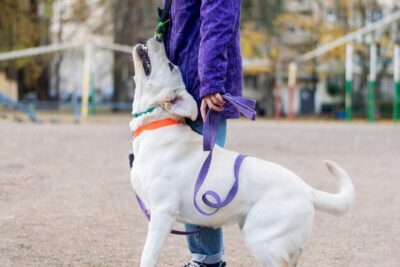If you’re a dog owner, there’s a good chance you’ve had to deal with the problem of pulling or leash aggression. It can be a real pain in the ass, but this guide on how to stop leash pulling in 5 minutes will teach you how to prevent your dog from pulling on the leash and how to train them to walk politely at your side.
Start by ensuring your dog is correctly fitted with a comfortable, well-fitting leash, collar, or harness. Use the proper size, so they don’t choke themselves while pulling.
Next, ensure you have plenty of treats to reward your dog for good behavior. When they begin to pull on the leash, stop moving and wait for them to stop hurting. When they do, immediately reward them with a treat and praise.
How to stop leash pulling in 5 minutes
Leash pulling is a common issue for dog owners but can be frustrating and dangerous. Here are a few tips to help stop leash pulling in just five minutes:
Use a front-clip harness instead of a collar. This type of harness puts pressure on the chest and shoulders, which makes it harder for the dog to pull.
Start walking in the opposite direction of your dog. This will cause your dog to turn and follow you, which will help to establish you as the leader.
Use a short, snug leash. A short leash will give you more control over your dog, and a snug leash will prevent your dog from pulling.
Use a treat to distract your dog. Hold a treat in front of your dog’s nose, and when they stop pulling, give them the treat and praise them.
Repeat the above steps until your dog stops pulling. It may take time and patience, but your dog will learn to walk nicely on a leash with consistent training.
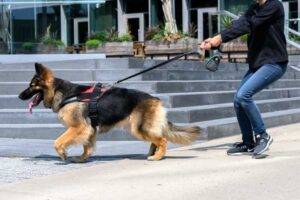
How to walk a dog that pulls
Walking a dog that pulls on its leash can be frustrating, but there are steps you can take to help prevent pulling and make your walks more enjoyable. Here are some tips for walking a dog that pulls:
Use a training collar or harness specifically designed to help prevent pulling. This will give you control over your dog and make it easier to stop them from pulling.
Practice walking your dog on a loose leash in a quiet area with few distractions. This will make your dog familiar with walking on a loose leash and make it easier for them to focus on you.
Whenever your dog starts to pull on their leash, stop immediately and do not move forward. This will signal to your dog that pulling on the leash is not an effective way to get where they want to go.
Once your dog stops pulling and is walking on a loose leash, please give them a treat and praise them for good behavior. This will reinforce the behavior you want to see and make it more likely that your dog will repeat it.
Gradually increase distraction and challenges as your dog improves until it can walk on a loose leash in all environments. This will help your dog learn to focus on you and not be distracted by their surroundings.
Remember to be patient and consistent, and reward your dog for good behavior. With time and practice, your dog will learn to walk on a loose leash, and your walks will be more enjoyable for you and your furry friend.
How do I get my dog to stop pulling on hard on walks?
One way to get your dog to stop pulling on the leash is to use a training technique called “positive reinforcement.” With this technique, you reward your dog for walking without pulling on the leash by giving those treats or praise.
You can also use a special harness or collar that helps to prevent your dog from pulling. Another tip is to ensure you are not accidentally reinforcing the behavior by moving forward whenever your dog pulls on the leash. Instead, stop and wait until they stop pulling before continuing to walk.
Another technique is to change direction every time your dog pulls on the leash. This will teach them that pulling on the leash won’t get them to their destination. You can also use a harness or head collar to help control your dog’s pulling behavior.
These devices can give you more control over your dog’s head and body, making it easier to redirect them when they pull.
Finally, providing your dog with regular exercise and mental stimulation is essential to help them stay calm and focused during walks. This can help reduce their desire to pull on the leash.
What’s the best thing to stop a dog pulling?
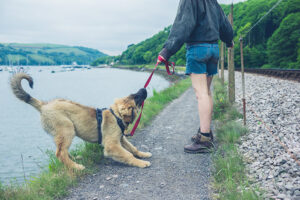
The best way to stop a dog from pulling on the leash will depend on the individual dog and its specific behavior. Some techniques that may be effective in preventing a dog from pulling on the leash include:
Stop and stand still whenever the dog pulls on the leash. This will teach the dog that pulling on the leash will not get them where they want to go.
Change direction every time the dog pulls on the leash. This will teach the dog that pulling on the leash will not get them to its destination.
Use a harness or head collar to give you more control over your dog’s head and body. This can make it easier to redirect them when they start to pull.
Give your dog exercise and mental stimulation to help them stay calm and focused during walks.
Use positive reinforcement to reward your dog for walking calmly on the leash. This can include treats, praise, and other rewards.
Ultimately, the best approach to put an end to the dog pulling on the leash will depend on the dog’s behavior. Consult a professional dog trainer to address your dog’s pulling behavior.
Why do dogs pull so hard on leash?
Dogs may pull on the leash for a variety of reasons. One common reason is that they are excited to go for a walk and want to get to their destination quickly. Dogs may also pull on the leash if they are trying to chase after something, such as another animal or an exciting scent.
In some cases, dogs may pull on the leash because they are trying to escape from something, such as a loud noise or an unpleasant situation.
Finally, some dogs may pull on the leash because they have yet to be adequately trained to walk calmly on a leash. Providing your dog with regular training and exercise can help reduce their desire to pull on the leash.
How do I get my 3 year old dog to stop pulling on the leash?
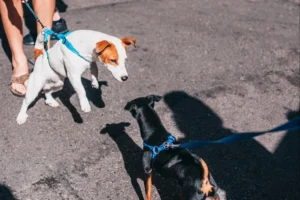
Teaching your dog to stop pulling on the leash is vital to being a responsible pet owner. It can be challenging, but you can train your dog to walk on a leash with patience and consistency. Here are a few steps you can follow to stop your dog from pulling on the leash:
Start by using a front-clip harness instead of a collar. This harness can help redirect your dog’s attention and prevent pulling.
Use treats and praise to reward your dog for walking nicely on the leash. Whenever your dog is walking next to you without pulling, please give them a treat and praise them. This will help reinforce the behavior you want to see.
If your dog starts to pull, stop walking and wait for them to stop pulling. Once they stop pulling, resume walking and reward them with a treat and praise. This will teach your dog that pulling on the leash will not get them where they want to go, but walking nicely will.
Practice this in short bursts, gradually increasing your time walking your dog. Be consistent with your training and always use the same commands and signals. This will help your dog understand what you expect from them and make it easier for them to learn.
Remember, training your dog takes time and patience. Keep going even if your dog learns right away. Keep practicing and be consistent with your training, and your dog will learn to walk nicely on the leash.
How do I leash trick to stop dog pulling?

To teach your dog not to pull on the leash, you can try using a training technique called “redirection.” Here’s how to do it:
Start by standing still and holding the leash loosely. If your dog starts to pull on the leash, don’t move. When your dog stops pulling and looks back at you, please give them a treat and praise them.
Repeat this process, gradually increasing the distance you walk and the amount of time your dog has to walk without pulling before they get a treat. If your dog starts to pull again, stop walking and stand still until they stop pulling and look back at you.
Over time, your dog should learn that pulling on the leash doesn’t get them anywhere, and they’ll start to walk more politely on the leash.
How do I stop my dog from pulling when we walk?
You can try a few different things to stop your dog from pulling on the leash while walking. One effective method is to use a front-clip harness. This type of harness attaches to your dog’s chest, which can help to redirect their attention back to you and discourage them from pulling on the leash.
You can also use a leash with a built-in training handle, giving you more control over your dog and making it easier to redirect their behavior.
Another option is to use a head collar, which fits around your dog’s head and snout and allows you to steer them in the direction you want.
Should I stop walking when my dog pulls?
It is generally a good idea to stop walking when your dog pulls on their leash. Pulling on the leash can be uncomfortable for your dog and make it difficult for you to control it.
Additionally, if your dog is pulling on the leash, it may be a sign that they need to be adequately trained and need additional obedience training. It’s essential to train your dog to walk politely on a leash so you can enjoy your walks together.
What do I do when my dog pulls?
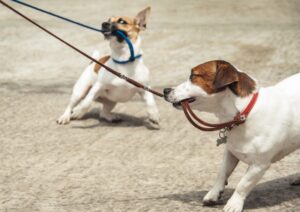
When your dog pulls on the leash, it can be frustrating for both you and your dog. It’s important to remember that pulling on the leash is common for dogs, especially when they’re excited or trying to get somewhere. To prevent your dog from pulling on the leash, there are a few things you can do:
Use a harness: A harness can help distribute your dog’s weight more evenly and prevent them from pulling as much.
Practice good leash-walking behavior: Teaching your dog to walk nicely on a leash takes time and patience, but it’s worth it. Start by walking in a quiet area with few distractions. If your dog starts to pull, stop walking and wait until they stop pulling before continuing.
Reward good behavior: When your dog walks nicely on the leash, praise them and give them treats. This will help reinforce good leash-walking behavior.
Use a training tool: Several training tools can help stop your dog from pulling on the leash, such as a head collar or a no-pull harness. These tools work by redirecting your dog’s attention and teaching them not to pull.
Remember to be patient and consistent when training your dog to walk nicely on a leash. Your dog will learn to walk on a leash without pulling with time and practice.
Do puppies grow out of pulling on the lead?
Puppies typically grow out of pulling on the lead as they age and learn to walk on a leash more appropriately. However, this will depend on the individual puppy and how much training and socialization they receive.
It’s important for puppy owners to consistently and patiently train their puppies to walk on a leash without pulling, using positive reinforcement and rewards for good behavior. This will help to ensure that the puppy learns to walk on a leash correctly and doesn’t develop bad habits that can be difficult to correct later on.
How do you stop a puppy pulling on a lead?
One way to stop a puppy from pulling on a leash is to use positive reinforcement training. This means rewarding the puppy with treats and praise when they walk on a leash without pulling.
You can also use a harness instead of a collar, as this helps distribute the pressure more evenly and make it more comfortable for the puppy.
Additionally, you can redirect your puppy’s attention by offering them a treat or toy to hold onto while they are walking on the leash. It’s also important to be consistent and patient with your training, as it can take time for a puppy to learn how to walk on a leash without pulling.
How to get large dog to stop pulling on leash
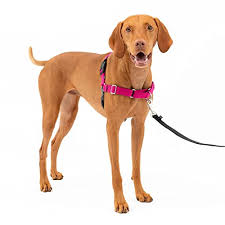
One way to get a large dog to stop pulling on the leash is to use a training collar, such as a martingale collar or a front-clip harness, which can help give you more control over your dog and reduce the pulling.
You can also use positive reinforcement techniques, such as rewarding your dog with treats and praise when they walk nicely on the leash, to encourage them to stop pulling.
Additionally, ensure that you are not inadvertently reinforcing the pulling behavior by moving forward or giving in to your dog’s pulling. Instead, stand still or change direction whenever your dog starts to pull to show them that pulling on the leash will not get them what they want.
What to use for a large dog that pulls on leash?
If your large dog pulls on the leash, you may want to use a harness or a head collar. These collars can help distribute the pressure evenly across the dog’s body, making it more comfortable for them to walk on a leash without pulling.
Some other options to consider include using a leash with some give to it, such as a retractable leash or a leash made of soft material, and using positive reinforcement training to teach your dog to walk politely on a leash.
How do I stop my stubborn dog from pulling on the leash?
If your dog is pulling on the leash while you are out on a walk, you can try a few things to stop this behavior. First, make sure you use a leash appropriate for your dog’s size and strength. A too-long or weak leash can make it easier for your dog to pull.
Second, try using a no-pull harness or head collar, which can help redirect your dog’s attention and make it easier for you to control them.
Third, reward your dog for walking nicely on a leash by giving them treats, praise, and affection.
Finally, if your dog continues to pull despite your best efforts, consider enrolling in a training class with a professional dog trainer who can help you and your dog learn to walk on a leash more effectively.

How do I stop my dog from pulling and lunging?
One way to stop your dog from pulling and lunging is to use a harness instead of a collar. This will give you more control over your dog and prevent them from pulling on the leash. You can also use a training leash, a short leash that attaches to your dog’s harness and allows you to control them more easily.
Additionally, you can teach your dog to walk on a loose leash by using positive reinforcement techniques, such as rewarding your dog with treats when they walk nicely on a leash. Finally, stay calm and assertive when walking your dog, as this will help reinforce good behavior.
How to walk a dog that pulls
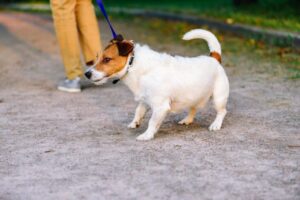
If your dog pulls while on a leash, it can be frustrating for both you and your dog. Here are a few tips to help prevent your dog from pulling on the leash:
Ensure your dog is adequately trained and knows how to walk on a leash. This means teaching your dog to stay by your side and not pull on the leash.
Use a leash appropriate for your dog’s size and strength. A harness can also be a good option for dogs pulling on a leash.
Start by walking your dog in a quiet area with few distractions. This will help your dog focus on you without being distracted by other things.
When your dog begins to pull on the leash, stop walking and wait until your dog comes back to your side. Then, continue walking.
If your dog pulls on the leash, try changing direction or turning around. This will confuse your dog and make them more likely to pay attention to you.
Reward your dog with treats and praise when they walk calmly on the leash without pulling.
Remember to be patient and consistent with your training. It may take some time for your dog to learn to walk calmly on a leash, but with practice and persistence, it will get the hang of it.
Conclusion
How to stop leash pulling in 5 minutes has been a quest of many pet owners, and we conclude on this note that one of the best ways to stop leash pulling is to teach your dog to walk on a loose leash. This can take some time and patience, but the following steps can help you get started:
Start by standing still with your dog on a leash. When your dog pulls, do not move forward. This will teach your dog that pulling on the leash will not get them where they want to go.
When your dog stops pulling, praise them and give them a treat. This will reinforce the behavior you want.
Gradually start walking forward again, rewarding your dog with treats and praise whenever they walk without pulling.
If your dog starts to pull again, stop moving and wait for them to stop pulling before continuing.
Practice this in different areas and with various distractions to help your dog learn to walk on a loose leash in any situation.
It’s essential to be consistent and patient when training your dog to stop leash pulling. It may take some time for them to learn, but with persistence and positive reinforcement, you can help your dog become a well-behaved leash-walker.

